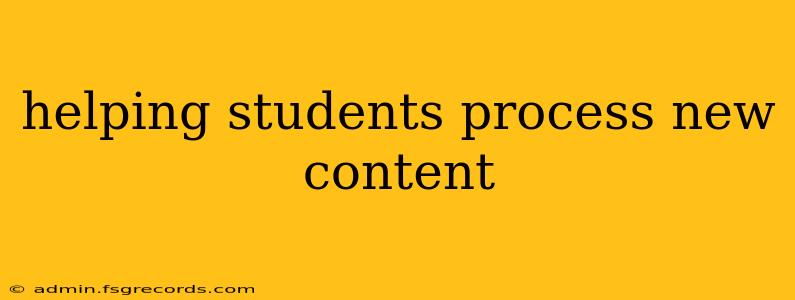Learning is a dynamic process, not a passive one. Simply presenting students with new content isn't enough; they need strategies to effectively process and retain that information. This article explores effective techniques to help students actively engage with new material, fostering deeper understanding and improved memory retention. We'll delve into strategies for various learning styles and offer practical tips for educators and students alike.
Understanding How Students Process Information
Before diving into strategies, it's crucial to understand the cognitive processes involved in learning. Students don't simply absorb information; they actively construct meaning through several key steps:
- Encoding: This is the initial stage where new information is transformed into a format the brain can store. Effective encoding relies on attention, organization, and association with prior knowledge.
- Storage: This involves retaining encoded information in memory. Different types of memory (short-term, long-term, working memory) play crucial roles in this process.
- Retrieval: This is the ability to access and use stored information. Efficient retrieval depends on effective encoding and storage, as well as retrieval cues.
Different learning styles impact how students navigate these stages. Visual learners benefit from diagrams and videos, auditory learners from lectures and discussions, while kinesthetic learners thrive through hands-on activities. Catering to diverse learning styles is key to maximizing learning outcomes.
Effective Strategies for Processing New Content
Here are some evidence-based strategies to enhance students' ability to process new content:
1. Active Recall and Retrieval Practice:
This powerful technique involves actively retrieving information from memory without looking at the material. Instead of passively rereading, students should test themselves through quizzes, flashcards, or self-explanation. This strengthens memory traces and improves retrieval efficiency.
- Example: After reading a chapter, students could close their books and try to summarize the key concepts from memory.
2. Spaced Repetition:
Reviewing material at increasing intervals strengthens long-term retention. Instead of cramming, students should revisit the material at spaced intervals, reinforcing learning and reducing the likelihood of forgetting.
- Example: Reviewing new vocabulary words daily for the first week, then weekly for the following month.
3. Elaboration and Interleaving:
Elaboration involves connecting new information to existing knowledge, creating a richer understanding. Interleaving involves mixing up different subjects or concepts during study sessions, promoting deeper processing and better discrimination between concepts.
- Example: While studying history, students could connect historical events to current events or personal experiences. Interleaving could involve switching between history and math problems during a study session.
4. Dual Coding and Multi-Sensory Learning:
Combining visual and auditory information enhances encoding. Using diagrams, videos, and audio recordings alongside text-based materials can significantly improve comprehension and retention.
- Example: Using mind maps to visually organize concepts, incorporating audio recordings of lectures, or watching educational videos.
5. Metacognition and Self-Regulation:
Encouraging students to reflect on their learning process (metacognition) empowers them to identify their strengths and weaknesses, adjust their learning strategies, and take ownership of their education. Self-regulation skills, such as time management and goal setting, are also crucial for effective learning.
- Example: Students can keep a learning journal, reflecting on their study techniques and identifying areas for improvement.
Role of Educators in Supporting Content Processing
Educators play a vital role in fostering effective content processing among students. This includes:
- Providing clear learning objectives: Students need to understand what they are expected to learn.
- Structuring lessons logically: Well-organized lessons facilitate easier encoding and storage.
- Using diverse teaching methods: Catering to different learning styles enhances engagement and comprehension.
- Incorporating active learning activities: Engaging students in discussions, group work, and hands-on activities promotes deeper processing.
- Offering regular feedback: Providing timely and constructive feedback helps students monitor their progress and refine their learning strategies.
By implementing these strategies, educators and students can work together to transform the learning process from passive absorption to active engagement, leading to improved understanding, retention, and overall academic success. Remember that consistent effort and a willingness to adapt learning strategies are key components of successful content processing.

